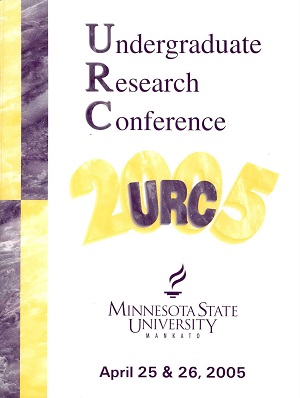Dissolved Organic Matter Characterization Using Fluorescence Spectroscopy and Singlet Oxygen Production Rate
Location
CSU 285
Start Date
26-4-2005 10:30 AM
End Date
26-4-2005 11:45 AM
Student's Major
Chemistry and Geology
Student's College
Science, Engineering and Technology
Mentor's Name
John D. Thoemke
Mentor's Department
Chemistry and Geology
Mentor's College
Science, Engineering and Technology
Description
Singlet oxygen is an important reactive oxygen species in sunlit natural waters and plays a role in numerous chemical processes. In particular, singlet oxygen is an important oxidizer in the degradation of many organic pollutants, including pharmaceuticals, personal care products, and pesticides. The interaction of sunlight with the dissolved organic matter (DOM) prevalent in these waters results in singlet oxygen production. The character of dissolved organic matter varies by location. These variations are relevant in attempts to accurately model the transport and fate of pollutants and natural water components, and can affect the bioavailability of nutrient elements such as nitrogen and phosphorus. Characterizing the type of DOM present in surface waters using fluorescence spectroscopy is a potentially relevant method for predicting degradation kinetics of pollutants in the environment, and other processes induced by reactive oxygen species. Surface water samples were collected to fulfill a range of locations and conditions. Excitation-emission (EEM) fluorescence spectra were acquired for each sample and major spectral features noted. Photolysis experiments in natural sunlight were then performed using Furfiiryl Alcohol as a singlet oxygen probe. Singlet oxygen production rates were then correlated to EEM data and trends observed.
Dissolved Organic Matter Characterization Using Fluorescence Spectroscopy and Singlet Oxygen Production Rate
CSU 285
Singlet oxygen is an important reactive oxygen species in sunlit natural waters and plays a role in numerous chemical processes. In particular, singlet oxygen is an important oxidizer in the degradation of many organic pollutants, including pharmaceuticals, personal care products, and pesticides. The interaction of sunlight with the dissolved organic matter (DOM) prevalent in these waters results in singlet oxygen production. The character of dissolved organic matter varies by location. These variations are relevant in attempts to accurately model the transport and fate of pollutants and natural water components, and can affect the bioavailability of nutrient elements such as nitrogen and phosphorus. Characterizing the type of DOM present in surface waters using fluorescence spectroscopy is a potentially relevant method for predicting degradation kinetics of pollutants in the environment, and other processes induced by reactive oxygen species. Surface water samples were collected to fulfill a range of locations and conditions. Excitation-emission (EEM) fluorescence spectra were acquired for each sample and major spectral features noted. Photolysis experiments in natural sunlight were then performed using Furfiiryl Alcohol as a singlet oxygen probe. Singlet oxygen production rates were then correlated to EEM data and trends observed.



